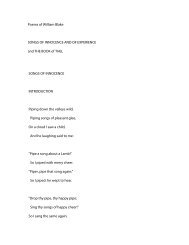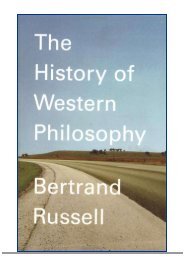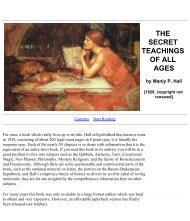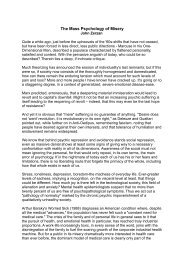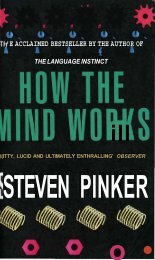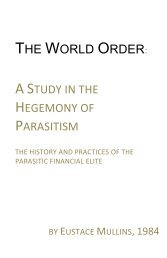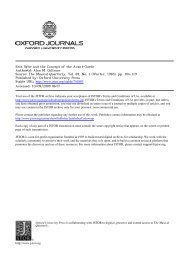order to obtain a sequential view of the various aspects, and the need tosynthesize or sum up these partial aspects which can only be realizedthrough our conceptualization. Previously, such "sheafing" of the varioussectors of vision into whole was possible only by the synthesizingrecollection of successively viewed aspects, and consequently such"wholeness" had only an abstract quality. ;In this drawing, however, space and body have become transparent. Inthis sense the drawing is neither unperspectival, i.e. a two-dimensionalrendering of a surface in which the body is imprisoned, nor is itperspectival, i.e., a three-dimensional visual sector cut out of reality thatsurrounds the figure with breathing space. <strong>The</strong> drawing is "aperspectival"in our sense of the term; time is no longer spatialized but integrated andconcretized as a fourth dimension. By this means it renders the wholevisible to insight, a whole which becomes visible only because thepreviously missing component, time, is expressed in an intensified andvalid form as the present. It is no longer the moment, or the "twinkling ofthe eye" - time viewed through the organ of sight as spatialized time - butthe pure present, the quintessence of time that radiates from this drawing.<strong>Ever</strong>y body, to the extent that it is conceived spatially, is nothing butsolidified, crystallized, substantivated, and materialized time that requiresthe formation and solidification of space in order to unfold. Spacerepresents a field of tension; and because of its latent energy, it is anagent of the critical or acute energy of time. Thus both energeticprinciples, the latency of space as well as the acuteness of time, aremutually dependent. When we formulate this thought in advance of ourdiscussion, it is to emphasize the basic import that we accord to thepresent, for both space and time exist for the perceptual capacities of ourbody only in the present via presentiation. <strong>The</strong> presentiation or makingpresent evident in Picassos drawing was possible only after he was able toactualize, that is, bring to consciousness, all of the temporal structures ofthe past latent in himself (and in each of us) during the course of hispreceding thirty years of painting in a variety of earlier styles.This process was unique and original with Picasso. By drawing on hisprimitive, magic inheritance (his Negroid period), his mythical heritage (hisHellenistic-archaistic period), and his classicistic, rationally-accentuatedformalist phase (his Ingres period), Picasso was able to achieve theconcretion of time (or as we would like to designate this new style whichhe and his contemporaries introduced in painting, "temporic concretion").Such temporic concretion is not just a basic characteristic of this particulardrawing, but is in fact generally valid: Only where time emerges as purepresent and is no longer divided into its three phases of past, present andfuture, is it concrete. To the extent that Picasso from the outset reachedout beyond the present, incorporating the future into the present of hiswork, he was able to "presentiate" or make present the past. Picassobrought to the awareness of the present everything once relegated to thedormancy of forgetfulness, as well as everything still latent as somethingyet to come; and this temporal wholeness realized in spatiality and28
endered visible and transparent in a depiction of a human form, is theunique achievement of this temporic artist.We shall in consequence designate as "temporic" artists those painters ofthe two major artistic generations since 1880(i.e., following the classicistic,romantic and naturalistic movements) who were engaged - doubtlessunintentionally – in concretizing time. From this point of view, all of theattempts by the various "movements" - expressionism, cubism,surrealism, and even tachism - show as their common trait this struggle toconcretize and realize time. Understandably, such experimentationresulted in numerous faulty solutions; but as we noted earlier, such faultswere equally unavoidable during the search for perspective and spatialrealization.<strong>The</strong> unavoidable attempt to presentiate the past, for instance, wasaccompanied by a certain chaos; yet this very chaos is always evidentwherever a once-valid world begins to undergo a transformation. In thisinstance many contemporary artists, including a majority of the surrealistsand later the tachists, were inundated by an inflation of time; a seeminglyendless quantity of exhausted residua was dredged up and revived fromthe past, engulfing those artists unable to master this reawakenedheritage. This has its parallel in the inflation of unconscious residua whichhave become conscious in the wake of efforts begun by Freud. Instead ofthe wholeness these artists had hoped for, they inherited a world of bitsand pieces; instead of attaining the spiritual supremacy they had desired,they became decidedly psychistic. By "psychistic" we mean contemporaryWestern man's inability to escape from the confines of the psyche. Evenamong Picassos works we find those which mirror such psychic chaos andpsychistic inflation. Had he created only pictures in this chaotic manner,we could not definitively number him among the greatest temporic artists;there are, however, many other works by Picasso, notably from the1930s,that bring his temporic endeavours toward a solution. We shallconsider here only two types of pictures: some specific portraits as well asa landscape painting. (<strong>The</strong> extent to which Picasso's still life paintingsexemplify the concretion of time, and also to what extent temporic art isanticipated in impressionism and even in earlier art, as in the work ofDelacroix, will be examined later in greater detail.)Among the portraits to which we refer are several executed since 1918inwhich Picasso shows the figure simultaneously "full face" and "profile," inutter disregard of aesthetic conventions (fig.2). What at first glanceappears to be distorted or dislocated, as for example the eyes, is actuallya complementary overlapping of temporal factors and spatial sectors,audaciously rendered simultaneously and conspatially on the pictorialsurface. In this manner, the figure achieves its concrete character ofwholeness and presence, nourished not by the psychistic demand forbeauty but by the concretion of time.In the drawing of fig.1, as well as in the portraits, the unimaginable and29
- Page 5 and 6: deficient forms which have become a
- Page 7 and 8: they could not reach their intent w
- Page 9 and 10: identity, or with his being equated
- Page 11 and 12: was especially influential on Greek
- Page 13 and 14: anticipated by Pope Sabinus, who in
- Page 16 and 17: discovery of Augustine's words. "I
- Page 18 and 19: concretion of space, our epoch is c
- Page 20 and 21: While plumbing the hidden depths of
- Page 22 and 23: With Leonardo the perspectival mean
- Page 24 and 25: perspective, had become common prop
- Page 26 and 27: not an avenue. Although man's horiz
- Page 30 and 31: the truly unrepresentable become ev
- Page 32 and 33: apparent in the development of aper
- Page 34 and 35: characteristics of the structures,
- Page 36 and 37: Structureaugmentation, a loss or a
- Page 38 and 39: "silenced music" of which St. John
- Page 40 and 41: meantime the integral perception an
- Page 42 and 43: homogeneity of the viscera, as well
- Page 44 and 45: Archaic — OriginaryMagicempathy a
- Page 46 and 47: IntegralCreed)Method(Divinity)(Eteo
- Page 48 and 49: that structure itself. Orestes' act
- Page 50 and 51: in its silent meaning, for he dedic
- Page 52 and 53: directed way, and to a mythical dem
- Page 54 and 55: Even though we may be unable to do
- Page 56 and 57: of arational possibilities which ar
- Page 58 and 59: chapters 5, 6, and 7, we would like
- Page 60 and 61: presupposes in any event the mental
- Page 62 and 63: capability is being formed in him w
- Page 64 and 65: At the moment when consciousness be
- Page 66 and 67: temporal aspects enumerated. We are
- Page 68 and 69: understanding the phenomenon of tim
- Page 70 and 71: temporal forms which co-constitute
- Page 72 and 73: crystallizing in a new perception o
- Page 74 and 75: dream-like and somnolent aspects an
- Page 76 and 77: ealization now manifesting itself a



